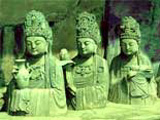 By pledging to keep the Dazu rock carvings as a world heritage site, the local people, especially the Chongqing municipal government, are determined to shoulder the heavy responsibility of protecting and preserving the centuries old art.
By pledging to keep the Dazu rock carvings as a world heritage site, the local people, especially the Chongqing municipal government, are determined to shoulder the heavy responsibility of protecting and preserving the centuries old art.
What they have accepted is daunting. Over the past centuries, the carvings have been threatened by erosion from constant rainfall, dampness and pollution and, to a lesser extent, tourists.
The heavily industrialized Chongqing Municipality has been plagued by acid rain, which also remains as a big threat to the grottoes.
According to Wen Rujun, an official with the Municipal Planning Committee of Chongqing, the municipal government has made it a priority to tackle environmental pollution.
Meanwhile, chemical protection engineers have also been working hard to help reduce erosion, fight flooding and strengthen the carvings.
One of the materials they have applied is organosilicone. It is the same color as the rocks and can make its way into tiny cracks in the carvings to hold broken parts together.
But researchers have been cautious about using organosilicone or other glues. This costly method has been applied in a very limited area because it only lasts about seven years and relic conservation scientists around the world are still trying to find better methods, according to Tong Dengjin, curator of the Dazu Rock Carving Art Museum.
Flooding is another direct threat to the carvings. The mountains are sandstone, which easily wears out during droughts and floods.
The China Cultural Relics Institute and the museum have jointly designed and carried out a project to save the carvings from flood damage.
In the Beishan and Baoding areas, researchers have built waterproof eaves and dug holes above or behind the caves to divert rain from the cave interiors.
To prevent the carvings from clasping as the original hard rocks soften, researchers have also had concrete columns built to support the rocks.
Giant steel nails were erected to connect broken rocks and bolster descending rocks.
The local experts have also adopted measures to limit the human impact, especially the tramping of tourists, Tong said. Today, less than 200,000 people live in Dazu County.
Only 5,000 visitors are allowed admission every day to each of the major rock carving sites and cars are prohibited from entering protected areas, Tong said.
Local people are still able to build hotels, restaurants, vendor stalls and other facilities away from the carvings.
A sewer system that can dispose of rubbish left by tourists has been built inside the scenic area.
The Dazu Grottoes have been becoming more popular with visitors since they were listed on the world heritage charter at the end of 1999.
From then on, a total of 10 million visitors from home and abroad have seen the carvings, according to Tong.
In terms of revenue, ticket sales in 1999 was 9.4 million yuan (US$1.14 million). The amount reached 12.02 million yuan (US$1.45 million) in 2000 and 15.36 million yuan (US$1.86 million) in 2001. In 2002 it is expected to hit at least 20 million (US$2.42 million).
But Tong said the museum loses at least 1 million yuan (US$120,000) each year by offering discount and free tickets to students and others.
He pointed out the honor of becoming a world heritage site has also raised the conservation, research and management standards even higher.
As a result, the museum is in great need of money and technical support, Tong said, despite past endeavors of researchers.
According to Tong, the museum was established about 20 years ago to manage the ancient carvings.
Since then, it has given part of its revenue from ticket sales to the county.
Tong said management now finds it "hard to make ends meet." For instance, the number of museum staff has risen from 52 in 1999 to 180 today.
"We need to do a lot of more work," he said.
For instance, the museum's project to open a special website for the rock carvings is still only on paper.
All sites, including the best-preserved Baodingshan area, need further conservation work.
Tong has mapped out an ambitious 15-year plan for the conservation and research of the carvings and inscriptions.
The plan includes integrating other local cultural heritage sites, such as an old Dongyue temple and a Taoist temple.
Tong said management plans to install an electronic monitoring system in the Baodingshan and Baishan areas, which are now guarded by staff members who take shifts on the mountain paths and valleys around the clock.
To make the plans a reality, money, skilled workers, experienced technicians and effective conservation technology is needed.
Tong said he is planning to set up a foundation for the carvings in the hope of getting more help from Chinese society and lovers of the local rock art.
(China Daily December 4, 2002)
|

